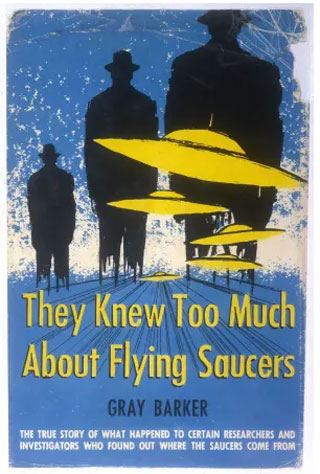
According to the history, Harold Dahl was on a conservation mission at Puget Sound, a cove near the east coast of Maury Island in Washington, collecting water snares when he saw six thread-shaped objects hovering about half a mile above the boat. Shortly after, one of them fell, followed by a shower of metal wreckage, some of which hit Dahl’s son, Charles, in the arm, as well as the family dog, which did not survive the injuries.
Dahl managed to take some photos of the aircraft with his camera, which he later showed to his supervisor, Fred Crisman. Skeptical, Crisman returned to the scene to check and saw a strange aircraft with his own eyes.
The next morning, Dahl was visited by a man in a black suit. They ended up at a local restaurant, where the man was able to tell in extraordinary detail what Dahl had just experienced.
“What I said is proof to you that I know a lot more about this experience of yours than you would like to believe”, said the man, according to author Gray Barker’s 1956 book, “They Knew Too Much About Flying Saucers.”

Dahl was instructed not to talk about the incident anymore, if he did, bad things would happen.
Maury Island’s events continue to fuel conspiracy theories to this day, although a U.S. government investigation at the time found it a hoax after Dahl and Crisman later admitted it. In particular, the mention of the man in black suit, which would evolve into an obsession for UFO enthusiasts and spread in American popular culture, yielding a number of comic books and movies.
There are different versions of men in black, but in all their goal is the same: to silence witnesses of strange paranormal phenomena.
They almost always wear black suits and hats with sunglasses, drive black cars and arrive in groups of two or three. Some describe them as fbi agents, while others describe them as having strange appearances, sometimes with supernatural features such as bright eyes and strange skin.
From Harold Dahl to Hollywood
“The transformation of the story from a first press report into a folk tale into a comic book and now into a film illustrates how the myth is transformed”, wrote Phil Patton in The New York Times at the time the first Men in Black movie released in 1997.

The first reported was made by Kenneth Arnold, a pilot who had his own alleged UFO sighting on June 24, 1947, near Mount Rainier in Washington.
Although it happened three days after the incident on Maury Island, it was the first widely publicized sighting and soon becoming a sensation, as was written in a 1949 government report on “Flying Saucers”.
The report states that Dahl and Crisman searched a Chicago magazine in an attempt to sell their story, and the magazine’s editor contacted Arnold, hoping he could help with the verification. Arnold then “summoned two Army A-2 Intelligence officers to assist in investigating Dahl and Crisman’s claims,” according to the report.
In July 1947, two Army A-2 Intelligence officers went to investigate the case and after departing Maury Island on a B-25 plane the next day, the plane caught fire and crashed, killing the two officers, which did nothing to calm the cheer of UFO enthusiasts.

But the Maury Island story gained little attention in the UFO community until the release of Gray Barker’s 1956 book, in which he wrote about his “Maury Island Case Archive,” which consisted largely of the writings of Ray Palmer, the editor of Chicago’s Amazing Stories Magazine.
Barker went on to connect the dots between “the man who wore a black suit”, which led Dahl to the restaurant and the three men in similar clothes who visited a young UFO enthusiast named Albert K. Bender, in 1953.
Barker’s book told bender’s story, thus introducing the concept of MIB (Men In Black) to a much wider audience.
“He has an important legacy. Prior to its publication, no one outside a very restricted group of flying saucer bulletin subscribers had ever heard of Bender, or the MIB”, said Robert Sheaffer, a UFO researcher.
Barker described Bender’s visitors as: “Three men in black suit with threatening expressions on their faces. Three men who come at you and make certain demands. Three men who know you know what the records really are!”
Bender, in his own 1962 book, Flying Saucers and the Three Men, described the MIB in much scarier language.
“They floated about 30 centimeters from the ground (…) They looked like clerics, but wore homburg-style hats. The faces were not clearly discernible, for the hats hid them and partially protected them … The eyes of the three figures suddenly lit up like lantern lamps (…) They seemed to burn in my soul as the pains above my eyes became almost unbearable”, Bender wrote.
Barker would write several other books related to the paranormal and UFOs, including “The Silver Bridge” from the 1970s, which helped spread the story of another popular paranormal figure, the “Mothman”, which became the 2002 movie “The Mothman Prophecies”. But how much of his writings were done in good faith was questioned by many in the UFO research community.
“Barker made it clear to me that he didn’t take the MIB or Mothman very seriously”, says Sheaffer, who corresponded with Barker on a few occasions. “However, he believed that there was still ‘something mysterious’ in the whole UFO phenomenon and the paranormal thing.”
Regardless Barker’s motives, numerous encounters with the MIB have been reported since the book “They Knew Too Much About Flying Saucers” was published almost 60 years ago.




















